So you’ve decided to get into vinyl records. Great! In our humble opinion, music on vinyl is the most rewarding listening experience of all.
But should you buy a turntable or a record player? The two terms are often used interchangeably, which often causes confusion for those just starting out with their record collection.
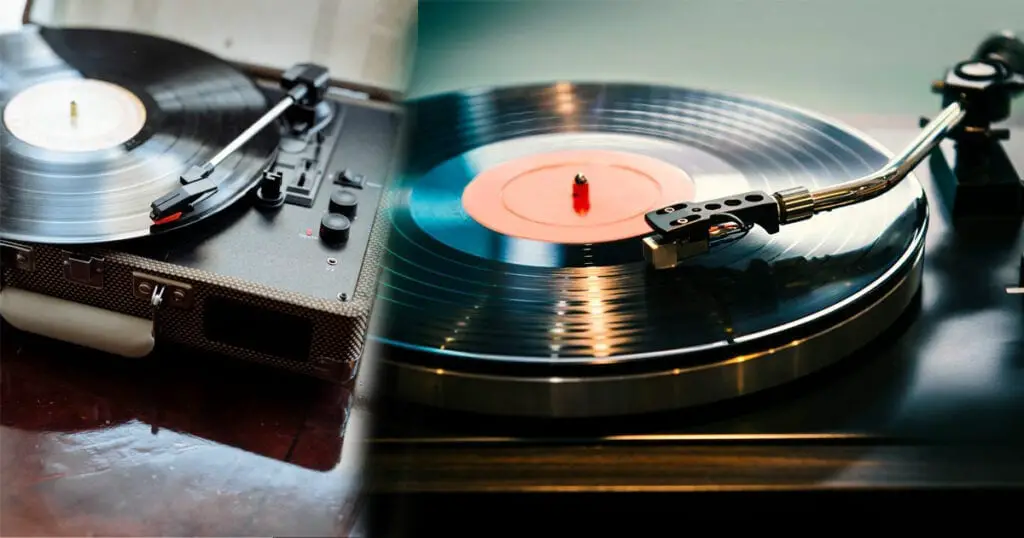
So what’s the difference between a turntable and a record player?
It’s turntable vs record player in the ultimate vinyl showdown!
In all seriousness, there’s a little history behind the differences and why the terms are often interchangeable, but to start, here’s the consensus view by today’s standard:
Turntables
A turntable is a stand-alone device designed to play your records and send the signal out to your HiFi system for amplification. The core components are as follows:
- A plinth (the base).
- A platter (the turntable that spins).
- A tonearm, cartridge, and stylus (the components that track your records).
Turntables do not have speakers, so you’ll need to connect this device to a receiver or amplifier before the music can play through a set of speakers.
In-between the turntable and your amplifier, you will also need a phono preamp to produce a full-frequency response. Below is an example of a great affordable turntable – the U-Turn Orbit.
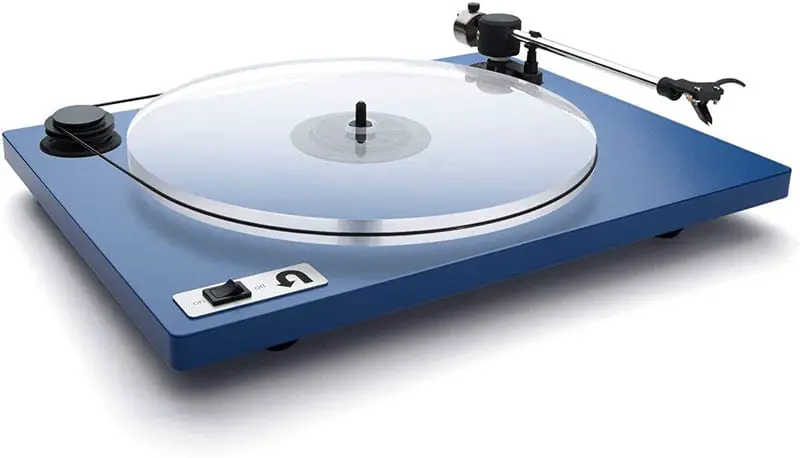
What is a Phono Preamp?
A phono preamp (or phono stage) is an audio component that performs two critical functions. Firstly, it will amplify the signal level up to a level suitable for the standard AUX input on your system. Secondly, it will apply an equalization curve to inverse the standard frequency adjustment made during the record cutting process.
You see, the signal produced by a record cartridge is very weak (much lower than the standard “line-level signal” produced by other consumer Hi-Fi electronics). Also, when a record is cut, the bass frequencies are reduced, and the high frequencies are boosted. This equalization helps to permit longer recording times by keeping groove dimensions small, while also increasing sound quality and decreasing record wear. To play back a record, we need to reverse this process. Otherwise, the music will sound tinny and very quiet. A phono preamp does this by applying the industry standard RIAA (Recording Industry Association of America) equalization curve. To learn more about this process in detail, check out our article ‘why do I need a phono preamp’
Some turntables have a built-in phono preamp, but most will require you to buy an external device, or plug into a phono preamp built into your receiver or amplifier.
Record Players
These days, most regard record players as devices that combine all the required components to play back and listen to records in a single device. Thus, the turntable, preamp, amplifier, and speakers are all housed in a single unit.
Record player example: Crosley all-in-one record player with built in speakers and bluetooth.
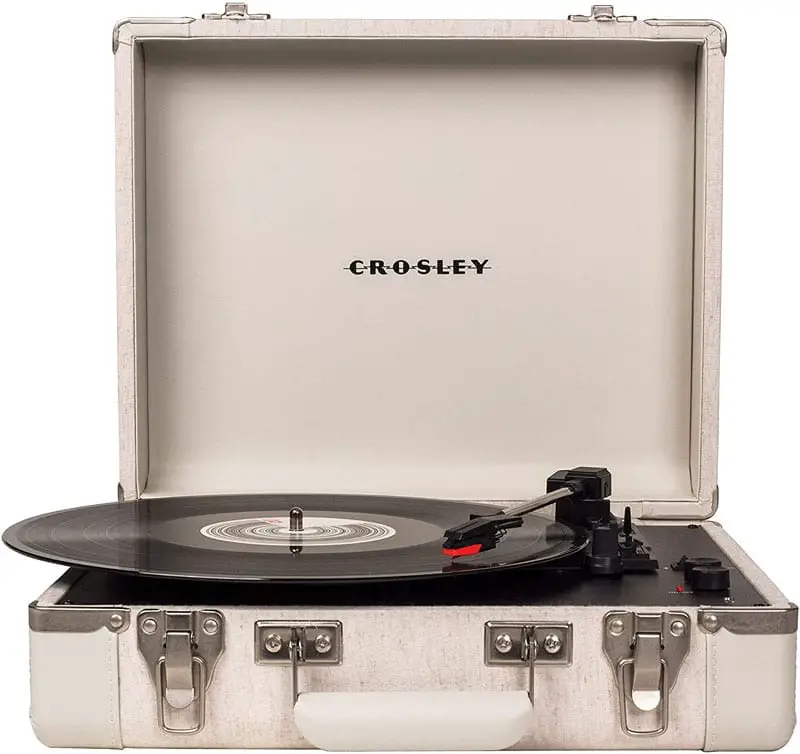
Examples of Different Turntable Setups:
Below are some turntable setup examples, simply demonstrating different configurations when hooking a separate turntable up to your speakers. These are just some examples for the purpose of demonstration.
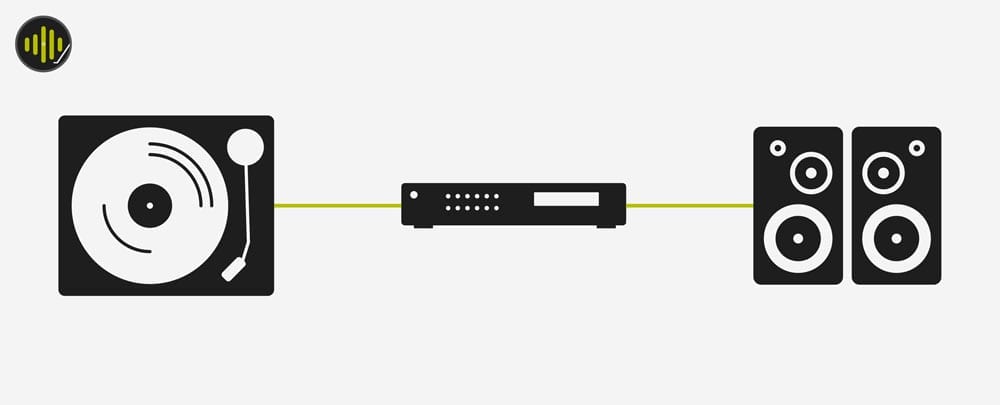
Above is a simple setup comprising of a turntable, integrated amplifier with built-in phono preamp, and a set of passive speakers.
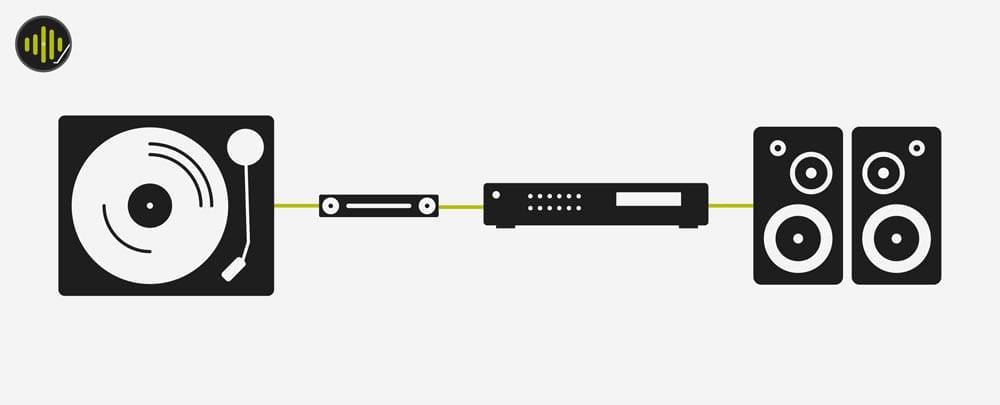
Stepping up from here, you can improve the sound quality by using a separate phono preamp between the turntable and your receiver/amplifier. As your system grows, you could choose to separate the preamp and power amp stages instead of using an integrated amplifier as show (which houses the preamp and power amp elements required to receive input devices and amplify them to your speakers.
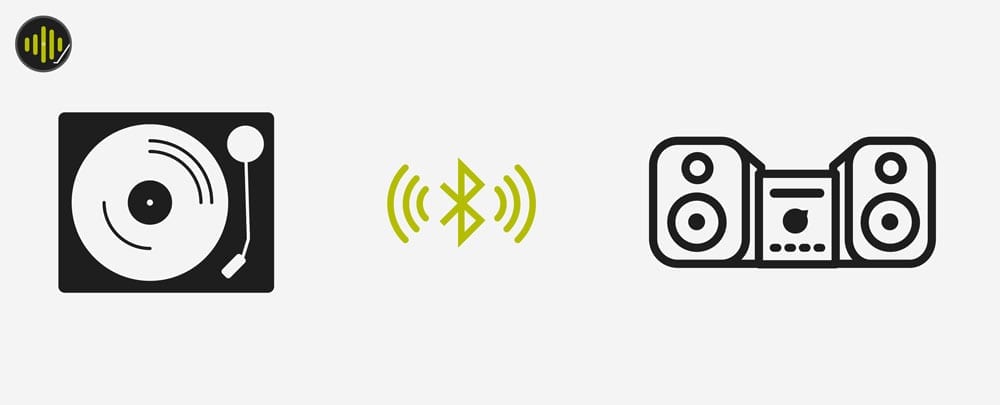
For simplicity, if your turntable has bluetooth connectivity, you could consider a direct bluetooth connection to your bluetooth speaker or Hi-Fi system.
Which is Better? Turntable or Record Player?
The answer depends on your intentions; are you getting into vinyl records for the sound quality and a Hi-Fi experience, or are you starting a collection mainly for the aesthetic and a retro vibe?
Also, what is your budget? Record players are generally a cheaper route to getting started with vinyl as they’re ready to go out-of-the-box without any additional equipment. Most modern record players sit in the affordable category these days, so it’s a quick and affordable way to start spinning records.
The trade-off, of course, is sound quality and performance. Like most things in Hi-Fi, the more you separate the components of a system, the better that device will perform the task. In summary, it’s all a matter of balancing convenience, price, and sound quality.
A good quality turntable will perform better in the three core areas of build quality, record wear, and, ultimately, sound quality.
Build Quality
Brands such as Victrola, Crosley, and Steepletone design all-in-one record players. They have a really appealing retro aesthetic, but most are designed for the affordable end of the market and do not have the same build or component quality as even some of the most affordable turntables.
Record Wear
Most record players aren’t built with quite the same attention to detail when it comes to tonearm performance, alignment, and tracking force. These components and settings are pre-set at the factory by design and are not user-adjustable in the vast majority of cases. The more accurately you can track the record groove, the kinder the process to the record groove. If the device isn’t precisely aligned and the stylus is tracking too heavy (or even too lightly), it will result in excessive groove wear.
The Bottom Line is Sound Quality
Every element of an audio system affects the final sound quality. With vinyl records, how accurately you track the record is so fundamental to the sound quality as no amount of improving on the signal from here will make up for poor quality tracking at the source.
With an all-in-one record player you are buying convenience and a fixed product. You can’t choose to upgrade parts of it further down the line, whereas with a turntable, you can easily swap the cartridge for something higher-end, perhaps upgrade the platter, or even (in some cases) change the whole tonearm. Not to mention, you’re in the driving seat when it comes the rest of your system too. Most built-in speakers on record players sound pretty underwhelming; turntables require you to have separate powered speaker systems, which means you can incrementally upgrade any part of the system as and when budget allows.
A Brief History of the Record Player and Turntable
To fully understand where the terms record player and turntable come from, we need to step back in time, back to the origins of recorded sound.
For a full history of record players and turntables, check out our previous article. For those in a hurry, here’s the short version:
It was a French inventor, Édouard-Léon Scott de Martinville, who first realized the process of recording sound back in 1857. His ‘phonautograph’ system was inspired by anatomical drawings of the human ear. It used a horn to collect sound, which was then passed through an elastic membrane attached to a stylus. This device would record sound waves by etching them onto sheets of paper. It could only visualize sound waves and could not play them back.
It wasn’t until Thomas Edison invented the phonograph that the world’s first commercially produced ‘record player’ capable of capturing and reproducing sound came into existence.
The concept initially comprised of a cylinder wrapped in tin foil that could be turned by a hand crank. When sound entered the mouthpiece, the diaphragm and attached needle would vibrate, making indentations in the foil.
Shortly after, Alexander Graham Bell made improvements on Edison’s invention. Principally he used wax in the place of tinfoil and a floating stylus instead of a rigid needle that would incise rather than indent the cylinder. Both improvements delivered superior sound quality and improved durability. This improved machine was called the graphophone.
The race was on to develop further improvements and see which system could have commercial success. In the end, it was Emile Berliner’s gramophone (invented in 1887) that would really set the stage for modern record players and turntables.
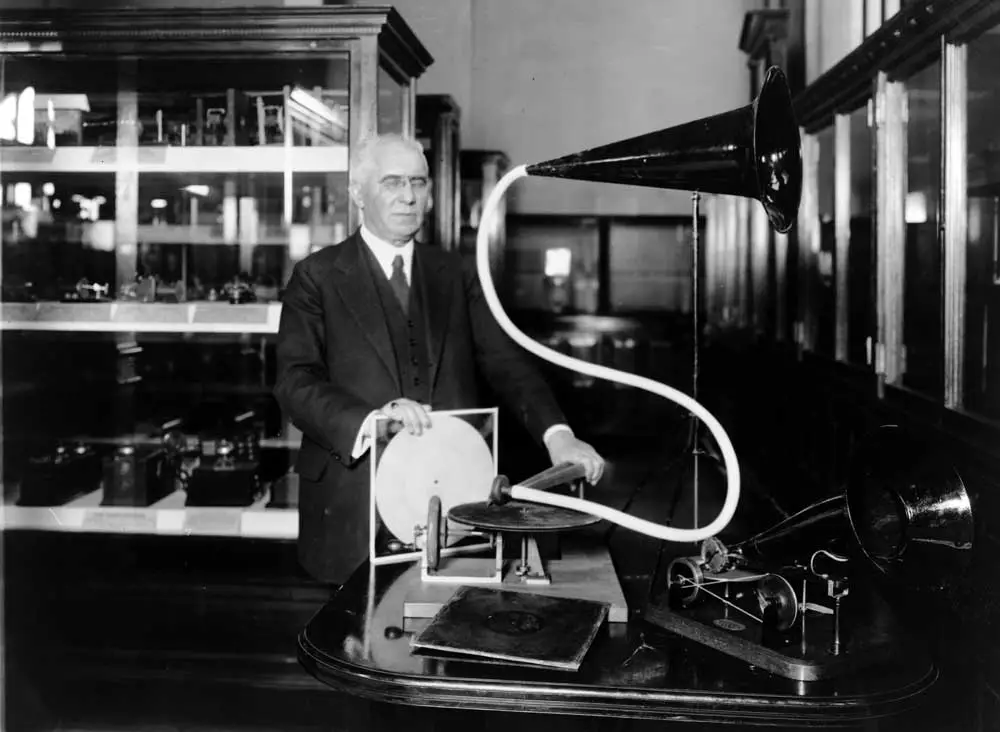
Berliner’s gramophone worked by etching recordings into a flat disc, rather than wax cylinders. The discs sat on a plynth that span, and thus we enter the era of record players with turntables.
Again, you can read our full history of record players and turntables for the detail, but the development of the first turntable-based record player is significant.
In the early twentieth century, we witness the birth of vinyl (a shift away from shellac records) and the birth of modern microgroove records. Columbia Records and RCA Victor introduced the modern 12-inch 33 1/3 RPM record and the 45 RPM 7inch single, respectively.
The invention of modern vinyl records, and the end of World War 2 saw hardware manufacturers redouble their efforts to produce affordable home record players. Philco was the first to introduce a range of all-transistor models in 1955. They were portable, battery-powered, and boasted a built-in amplifier and speaker.
Modern Turntables
High-fidelity made great advances through the late sixties and seventies, with the rise in popularity of stereo records and separate turntables that were either direct or belt-driven.
By the 1980s, most homes had a vinyl playing back system of some variety. Increasingly, these were ‘Hi-Fi’ systems made of separates (a turntable, radio, amplifier, and a cassette deck).
Of course throughout the 1980s, we see the rise of digital and the compact disc, with vinyl going into decline. DJ turntablism kept vinyl alive during the 90s and early 00s. DJs span records on a set of ‘DJ turntables’. This terminology is significant, as it is in part responsible for the distinction between record players and turntable.
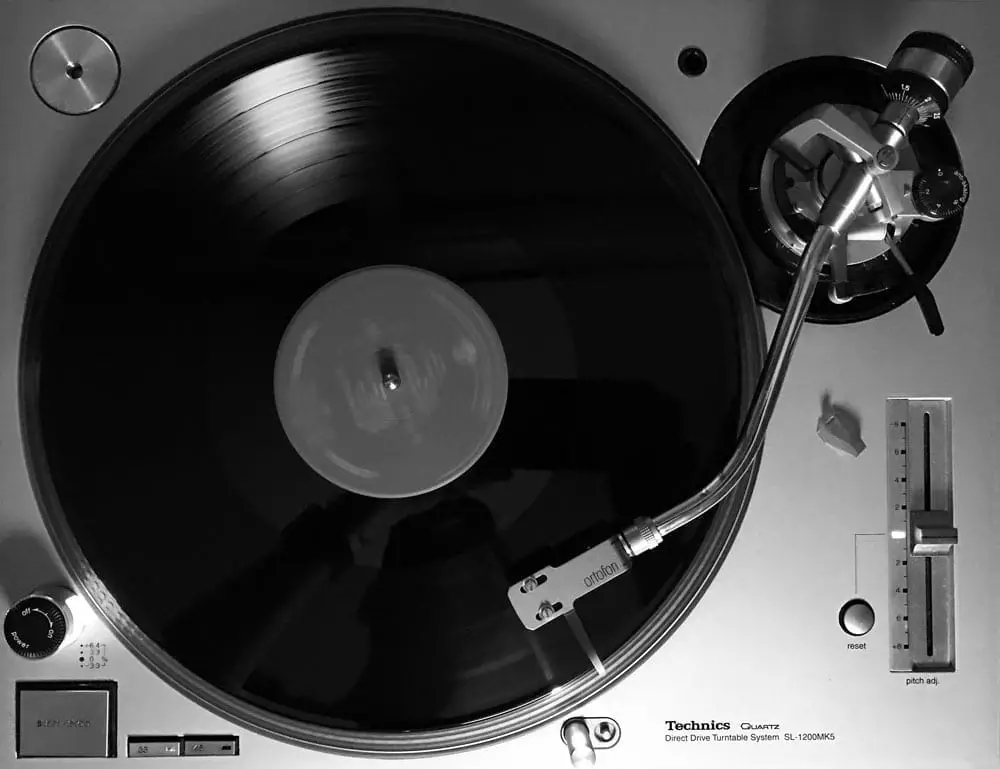
Turntable vs Record Player – The Bottom Line
Alright, so I breezed over the history quite a bit there, but it’s an important factor in understanding where the terminology comes from. Strictly speaking, a turntable is just one component in a device that plays records. However, by today’s standards, most regard record players as all-in-one devices that house all the parts required to spin the record and hear the music. Turntables are separate devices that require separate amplification and speakers. In the end, however, you choose to play your records, enjoy the music.

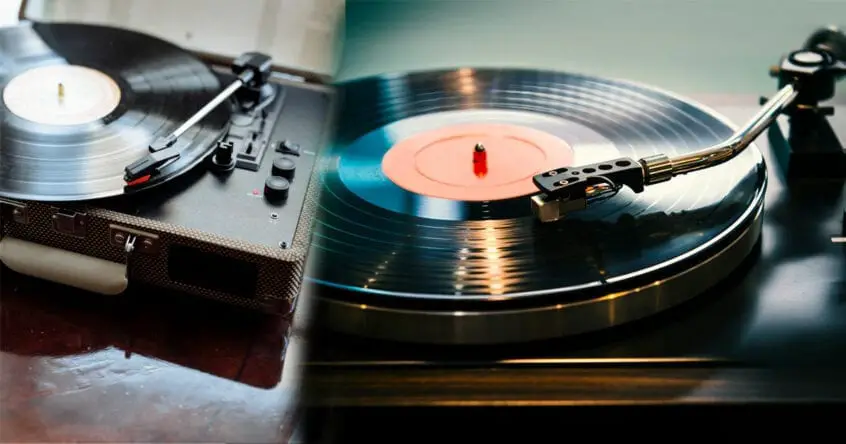


Nice article
Nice post,
Explained to perfection thanks for sharing
Great! Glad to help. Thanks for reading and your kind words.